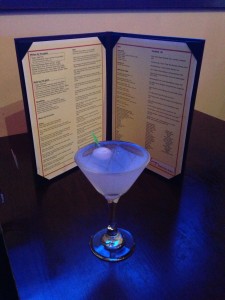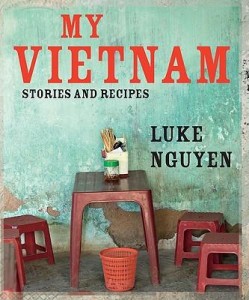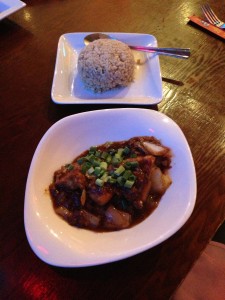Because cuisines are embedded within cultural identities, the question of “authenticity” and “authority” in creating Vietnamese food is a complex one. diaCritic Jade Hidle reflects on this question as she shares her experience exploring the Vietnamese American cuisine in the media and in everyday life.
Have you subscribed to diaCRITICS yet? Subscribe and win prizes! Read more details.
The last season of Top Chef has recently reached its end, and I miss scarfing candy and chips with Bitchin’ Sauce while I watched the weekly haute cuisine showdown. Refreshingly, two of the final three cheftestants were women, one Chinese American and the other from St. Lucia. (Both of these women unfortunately lost to the season’s token douchebag who turned every ingredient into a foam.) In applauding the diversity of the finalists, often uncommon in this reality show and others, I must reflect on a key intersection of race and food this past season.
Meet the self-proclaimed “Captain Vietnam.”

Featured prominently in an episode of the same name, cheftestant Travis Masar, who was eliminated midway through the competition, announced that he was an expert in Vietnamese cuisine, claiming that he acquired his culinary fluency during his travels to Viet Nam, but also through his love for Vietnamese men. During this confession, photos of Masar and his current Vietnamese boyfriend flashed across the screen. Masar proudly stated that he only dates Asian men. Masar publically exoticized Vietnamese men by tangling food and sex through a conflation of Vietnamese cuisine and bodies for their “consumability.” Top Chef appeared to be trying to be inclusive by representing a gay male couple, yet they did so in a way that was exclusionary to Vietnamese men, fetishized and objectified. Ironically (or appropriately), Masar repeatedly failed to cook and serve Vietnamese dishes to the panel of judges’ sharp palettes. In the episode in which Masar named himself “Captain Vietnam,” he made a tomato-based soup that looked like nothing I had ever seen before in my thirty years of living off of Vietnamese food, a dish that one of the judges critiqued for tasting more Italian than Vietnamese. The previous episode documented a similar kitchen folly, as he attempted a Vietnamese-style appetizer intended to showcase the aromatic flavor of lemongrass, but forgot to add the actual lemongrass.
What is interesting about Masar’s time on Top Chef is not just his appropriation of Vietnamese culinary culture, but how his dishes raised questions of authenticity. What does “real” Vietnamese food taste like? Who is able, or allowed to, make Vietnamese food the “right” way? Which eaters are in the position to assess the “authenticity” or “success” of Vietnamese cooking? There are, as diacritics guest blogger Dave Lieberman has pointed out, so many persisting stereotypes and misconceptions about Vietnamese food—the perception that it is dirty and weird and involves only the parts of animals that no one else wants to eat. Apparently, this is still a popular enough belief that one of my students openly asked me the other day if I eat dog. (I bit my tongue to refrain from sarcastically responding, “Of course, but only the face and the poop chute.”) Above all else, why, during a season set in New Orleans, didn’t Top Chef bring in local Vietnamese chefs to be part of the quickfire challenges or judging panels? After all, when the camera crews followed the cheftestants into the city to shop for food or supplies, I would often catch Vietnamese restaurant and shop signs in the peripheries of the shots.
These questions revolving around notions of authenticity and visibility of Vietnamese culinary culture are particularly intriguing given the outpouring of diasporic Vietnamese cookbooks in the past few years. To name a few, Luke Nguyen’s 2011 My Vietnam: Stories and Recipes, Nhut Huynh’s 2009 Little Vietnam, Charles Phan’s 2012 Vietnamese Home Cooking, and Ann Le’s 2011 The Little Saigon Cookbook: Vietnamese Cuisine and Culture in Southern California’s Little Saigon. All of their books widely available at Barnes and Noble, Nguyen and Huynh are Vietnamese Australian, whereas Phan and Le focus on Vietnamese culinary culture in California. Huynh and Phan point out in the autobiographical narratives that contextualize the recipes that they are ethnic Chinese. Their doing so, in addition to all of the authors’ concessions to Chinese and French culinary influences over the course of Viet Nam’s history, speak to the inherent transnational histories and ethnic diversity of Viet Nam that belie reductive notions of “authenticity.”
And, as the authors’ autobiographical portions of their respective cookbooks attest, foodways emerge as a shifting plain on which diasporic Vietnamese negotiate their identities. For one, these cookbooks articulate their authors’ ambivalence in oscillating between representing themselves as outsiders and insiders to Vietnamese culinary culture. They at once parrot the stereotypical assumptions about Vietnamese food and people—from the negatives of “messy,” “smelly,” and “mysterious” to the positives of “healthy,” fresh, and leisurely—but also divulge personal stories, family histories, and tips about Vietnamese cultural practices as a way of legitimizing their “Vietnameseness.” These authors seem to have to strike a balance between being “authentic” brokers of Vietnamese culinary culture while also being relatable enough to the non-Vietnamese audience in order to be approachable and marketable.
One of the narrative threads that cinches these cookbooks together is that the authors express their gratitude for being “saved” from Viet Nam by offering the reader food. So often portrayed as needing to be “saved,” the cookbook authors fulfill their debt for the “gift” of survival, to use Mimi Nguyen’s term, by granting the audience the gift of life in return: food. Within this context, the cookbooks become a form of entertainment, of culinary tourism accessible and safe enough to conduct in the comfort of one’s own kitchen, whereby diasporic Vietnamese pay off their perceived debt while readers also absolve lingering guilt of the witnessed atrocities committed in Viet Nam. Eat it up.
And what of second-generation Vietnamese Americans like myself who don’t know their way around the kitchen and find ourselves perusing these cookbooks or on Yelp! seeking restaurants that can satisfactorily replicate the flavors of our families’ kitchens?
Well, dear reader, let me share a story of one of my gut-clenching forays into the landscape of Vietnamese American cuisine…
Over the summer, I found myself in Cleveland, without much association with the city beyond The Drew Carey Show (Craig Ferguson, I have a schoolgirl’s crush on you and your swarthy Scottish studliness). It was there that I overheard this conversation between a couple sitting behind me at an Indians game: “If you could only eat one cereal for the rest of your life,” the girl begins, “what would it be?” “Hmm,” the boyfriend thinks, then spends about four minutes in a nasal, incapable-of-keeping-secrets-because-it’s-so-loud voice thinking aloud about the merits of Total and Raisin Bran. Mostly, though, he ponders the flavors of different variations of Cheerios. Finally, as I am beginning to lose the fight against self-eye-gouging for having to listen to his vanilla reasoning, he answers, resolutely and with an odd air of pride, “Cheerios. Original.” I looked to the sky for signs of fire and brimstone. It is my version of hell to be in a world where someone has free reign of cereal (have you seen the cereal aisle—sometimes plural aisles!—at an American supermarket? Excess defined.), yet he chooses Cheerios. Call Ripley’s. I found a dude born without tastebuds.

So, I should have known not to trust Cleveland area food reviewers. However, after my pleasant discovery of Vietnamese American space in Washington, D.C., earlier in my trip, I decided to search out the same in Cleveland. Without a cultural compass in the city, I turned to Yelp!. My previous experiences with Vietnamese restaurants on Yelp! have been ambivalent.
I do not know how to cook Vietnamese food. At all. Though its flavors anchor my earliest and most intimate memories of my mother’s house where Vietnamese food is always cooking, since I moved out on my own I have been relegated to the role of consumer. Vietnamese cuisine is something that I buy, or Yelp!. Whenever I have tried to edge my way into my mother’s kitchen to glean the songlines of her recipes, she has ushered me out of that space, that knowledge, with a click of her tongue and, sometimes, an urging for me to buy the dish because I’m “too busy to cook” or would “mess it up.” I am a consumer of my own culinary culture.
Although “authenticity” is a fabrication or at best a subjective barometer, I believe I know what good Vietnamese food should taste like to me, so I filter out the racist reviews, whether through demeaning or glorifying lenses, to seek out the comments posted by those who indicate they possess similar, earnest culinary knowledge. Who compares the texture of rice to their mom’s or the temple’s? Who differentiates between nước mắm and mắm nêm?
Desperate in my cravings for flavors of home-cooked meals, I overlooked the bland, bromidic musings of the Cheerio “brohioan” (this is actually a term I heard him and his male friends using to refer to themselves and each other—initiate self-eye-gouging sequence) and only cursorily skimmed the local Clevelanders’ starred Yelp! reviews before following their recommendations to a restaurant called Saigon, in the East Fourth Street destination (really just a hip alleyway) of downtown Cleveland.

Something struck me as off when I saw a cocktail menu propped open on the table. Never have I had a cocktail at a Vietnamese restaurant. Only water, tea, soda chanh, sua dau nanh, and the occasional rau ma. Cocktails belong to the sphere of happy hours with coworkers and acquaintances. The décor and ambiance resembled the money-making renovation and redesign tactics employed by “bar scientist,” and my other pop culture crush, Jon Taffer on the show Bar Rescue—the kind of young businessmen’s happy hour hot spot.

The wall sconces glowed blue and a signed Indians jersey hung in the entryway. It seemed as though this was another example of Asian American foodways—from restaurants to cookbooks—bending to the will of (white) American audiences, quelling their anxieties by attempting to transform perceptions of us as dog- and duck-eaters into inviting, clean, “America-friendly” spaces.
Aside from the staff, no Vietnamese people were dining in the restaurant. The man at the table next to me spoke in a voice indistinguishable from the “white people” voice Dave Chappelle mimicked on his defunct, much-missed show. I pushed the cocktail menu to the edge of the table.
Among all of the soup and noodle dishes the food menu offered, I ordered cá kho. I always eat cá kho when I miss my mom. She makes the best I’ve ever had, with caramelized sauce that is sweet and thick slathered over a braised fish filet steamed so gingerly it melts in the mouth.
Unlike my experience of easy conversation in Vietnamese while I was in Washington D.C.’s Eden Center, this Cleveland waitress visibly cringed when I ordered cá kho as “cá kho” and not whatever “steamed fish” or “claypot fish” English translation the menu listed. She was quiet for an extra beat, and when I looked up from my menu at her, the skin on her nose was crinkled, her lips parted as if words were caught between her mouth and the air. She responded to me in English. As I mentioned in my last post about D.C., I gauge my likelihood of returning to a Vietnamese establishment by how willing they are to accept “their” language coming out of my mouth. In D.C. I had no problems, was talking and joking with people easily in Vietnamese. But, this Ohioan was not having it. So, I followed her lead and proceeded to speak to her in English.
I should have known I would have to fill up on candy bars after the meal when the waitress asked me if I wanted white or brown rice with my dish. I know some second-generationers don’t eat white rice, on account of the carbs and whatnot, but I am not one of those. I ordered. Hesitated. But before she had a chance to walk away, I asked her if there are many Vietnamese in Cleveland. At first, she told me that there are “a lot.” Surprised, I inquired further about the community, if there are certain neighborhoods where I can go for food or shopping. Suddenly, there are “not a lot” of Vietnamese in Cleveland, she told me. “So there is no equivalent of Little Saigon here?” I asked. “That’s only in California,” she said. “We have one church.” Okay. But I didn’t debate her on this. “Oh, I’m actually from California!” I said instead, hoping this would facilitate a more comfortable conversation.
This was when the waitress began to switch between “we” and “they” in strange ways. “They don’t have a place where you can visit,” she said. Pronouns are tender strings of letters. It’s fire-stoking when a voice pits you as “them,” and heart-melting when a lover makes you part of “we.” Then she backpedaled and said that she didn’t know anything, that she just moved to Cleveland.
Was she being honest? Had I offended her? Did I come off as too touristy? Did I look like a duplicitous multiracial spy—an “undercover Vietnamese” as one of my friends jokingly calls me? I felt as though I had been turned into that in the span of just a couple of minutes. From this ambiguous fissure in our conversation, my own struggle with authenticity surfaced. Once she walked away to submit the order to the kitchen, I flip-flopped over questions. I wanted to ask the waitress, “Why the fuck did you move here if there is no community?” and, more vulnerably, “Why can’t I be part of it?” But maybe she wasn’t looking for a community. Maybe the assumption that she should says a whole hell of a lot more about me. Was I an insider or outsider to “Vietnameseness” here?
The cá kho dish that came to me was about half onion, cut into quarter-sized trapezoids that were barely sautéed. (I will pretty much eat anything, which a friend once told me is a quality of being a first-born child, but I refuse to eat onions, those filthy crimes against nature.) Sprinkled atop the bed of onions were three separate chunks of fish in a sugary brown sauce. I’m used to the traditional cá kho that comes in one filet, right down the middle of the fish’s body, as you would receive a steak. That’s the good stuff. I want to pull skinny bones out of my big, ravenous bites into that filet. I’ve always imagined the bones as cartilageneous versions of tiny conductors’ batons. Hungry, I scooped a chunk of the fish into my mouth and felt transported. Not to home, though. To Panda fucking Express.
Desperately needing flavor, I gave in and ordered a Lichitini off of that suspicious cocktail menu. (If there are any readers out there who own or work at an establishment serving drinks, please a protest against this hybridizing nomenclature of drink names. Martinis might be “chick drinks,” but just because I have a vagina and like sweet beverages doesn’t mean I want to utter stupid, misspelled, Dr. Moreau-like mixings of words.)

During this Lichitini lubrication that made the rest of the meal a little easier to swallow, I rambled at my dad—a white American through and through—who expressively suffered the blandest dish of lemongrass chicken I have ever tasted; upon first bite, he proclaimed, “This is just crappy Chinese food!” I thought aloud about how, despite my excitement to experience Vietnamese America via my tastebuds, maybe I shouldn’t judge this bland food. After all, here was an immigrant community obviously doing well in pricey real estate in a downtown metropolitan area. (But was that “success”?) And, though it wasn’t what I expected as a Vietnamese American girl from Cali, the food is a baby step for some of the Midwesterners who might not know some of those flavors. Maybe this is adventurous for some eaters.
“Maybe I shouldn’t judge,” I told my dad. “I shouldn’t expect ‘the Vietnamese way’ to be my way.”
“But that way is good!” my dad interjected, recalling thirty-year-old memories of the dishes that my mom used to cook for him when they were married.
With Lichitini running warm through my system, I got all loquacious about how my disappointment in this place was probably indicative of the vulnerability underlying my insistence on finding a sense of community amongst Vietnamese Americans in Cleveland, Ohio, of all places. I shouldn’t assume that all Vietnamese necessarily want to be part of a community like that in the U.S. Wanting that space, and to find certain flavors there, is my understanding of community and culture, but that viewpoint isn’t necessarily shared by everyone.
Are there readers out there who are as inclined as I am to venture away from the easy consumerism of Vietnamese food and attempt to cook our own dishes, either from a cookbook or from shadowing our kitchen-savvy relatives? Do I have companions in the quest to avoid kitchen fires and put something on a plate that doesn’t induce tongue-clicking from our mothers? Can we make our own flavors? Feed our children’s sweet mouths?
Until our future culinary adventures, dear reader, eat well.
Jade Hidle is a Vietnamese-Irish-Norwegian writer and educator. She holds an MFA in creative writing from CSU Long Beach and is working on a PhD in literature at UC San Diego. Her work has appeared in Spot Lit, Word River, and Beside the City of Angels.
Do you enjoy reading diaCRITICS? Then please consider subscribing!
Please take the time to share this post. Sharing (on email, Facebook, etc.) helps spread the word about diaCRITICS. Join the conversation and leave a comment! What determines the “authenticity” of Vietnamese food and who has the “authority” to create it?






Objectifying Vietnamese or “Asian” men may not be a bad thing because the stereotype has been the opposite which is that asian men have no sex appeal.
I find it rather amusing and ironic that a tall, blonde white male with blue eyes (the ideal man for the asian women who only date white guys) would only date asian men. It actually made me root for him and I’m not gay. I’ve often heard from many white men who date asian girls how ugly little asian men are no competition for them so his attitude is refreshing.
I’ve always thought it was kind of a strange and tragic expression of TV culture that we pit people against each other in the furious prepping and cooking of dishes–and at the same time still think about food as a way to express love and history and origin. I’m sure the judges of Top Chef would disagree with me, and John Taffer might deep fry me and serve me to a roomful of half-drunk quantifiables, but if food is a way of saying “I love you and I want to keep you alive and here’s one of the best most memorable ways to do it,” do we need freaking cameras and judges and gastro-foams?
Beautiful post!
Mike, that’s an interesting point that I feel keenly when Top Chef devises competitions wherein the contestants have to cook their favorite dishes from childhood; I always feel bad for the person who cooks his/her mother’s signature meal only to be critiqued and voted off for it. Thank you for reading and for the comment!
My Filipino home help and I (Singaporean Chinese) cooked a “thit xao mam ruoc” that for my Mekong Delta husband rhapsodized as “truly tasting of home”. We simply followed a Luke Nguyen recipe. Even his Can Tho sisters hadn’t been able to come up with a recipe that so replicated his mum’s style. Everything else we’ve cooked out of that book has raised pleasantly surprised eyebrows from the Viet Kieu community in Singapore. I’d say just buy a Luke Nguyen and start following the instructions.
Thank you for the tip, Audrey. I will definitely start trying out some of Nguyen’s recipes. I’m glad that they fed your family well!
I like Andrea Nguyen’s Into the Vietnamese Kitchen and Ann Le’s The Little Saigon Cookbook. But I’ve also discovered that many recipes have to be adjusted for one’s own taste. I haven’t used Charles Phan’s cookbook extensively, but some of the recipes are very good.